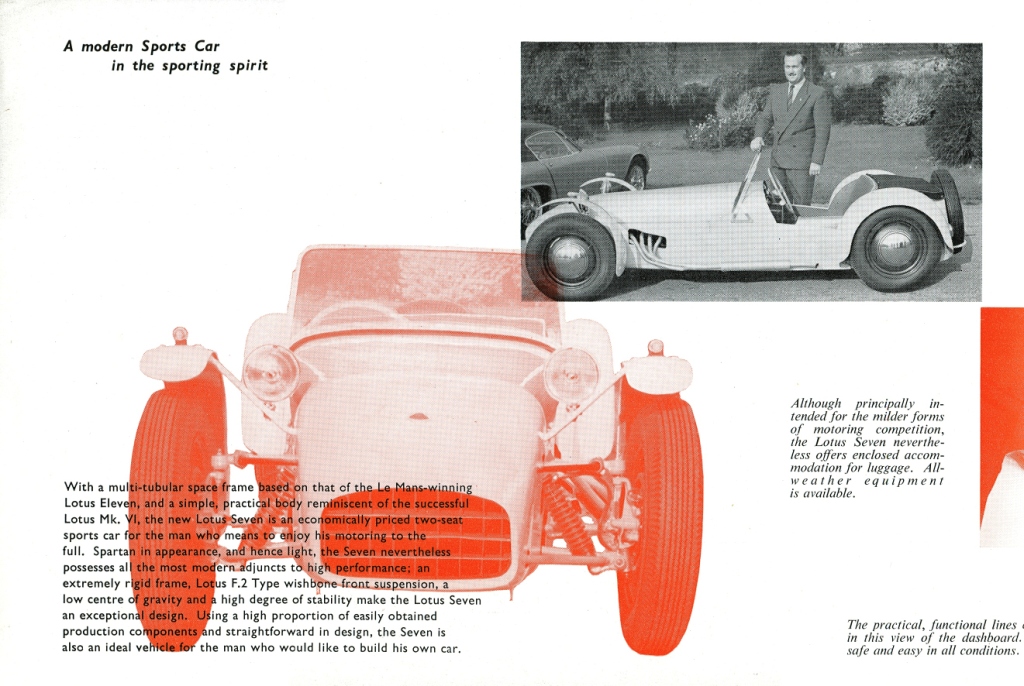 |
LOTUS SEVEN REGISTER |
the web site for the
Seven made by Lotus between 1957 and 1973
 |
LOTUS SEVEN REGISTER |
the web site for the
Seven made by Lotus between 1957 and 1973
SPECIAL
FACTORY PRODUCED SEVENS:
As mentioned
in the previous chapter, the Edward Lewis Seven was in effect a “Le Mans”
Eleven without the aerodynamic bodywork having de Dion rear suspension,
disc brakes to all wheels and aluminium Coventry Climax single overhead
camshaft engine. According to the records only five of these special cars
were produced by the factory; four with 1098cc. FWA engines and the fifth
with the larger 1460cc. FWB version. The FWA powered cars were:-
#400, the Lewis car already detailed which rumour has it was last heard of
somewhere in Africa.
#404 which
was supplied to Jack Richards who, as well as being a long standing Lotus
customer and successful competitor, was also Competition Secretary of Club
Lotus. This car was described in Ian H. Smith’s book as “one of the most
beautifully finished sports-racing cars ever to be seen – every possible
part on the engine was chromium plated, even down to the dipstick.” The
car is still in the U.K. with original specification.
#462 which was sold to Eric Pantlin, a motorcycle racer who had raced an
Eleven and a Jaguar XK150 during the 1957 season. Eric specialised in
short circuit racing and in 1959 had three 1st and two 2nd
places from eleven races. The car was found wrecked in a Cornish quarry in
1980 and was restored and is now believed to be in the U.S.A.
#479, the last of the FWA powered de Dion cars went to James Obeysekere, a
Junior Minister in the Ceylon (now Sri Lanka) government of the day. It is
believed to still be with him or his family today.
#421, the only 1460cc FWB powered de Dion Seven produced by the factory
was supplied to Paul Fletcher in exchange for his Porsche 356 which
Chapman wanted for personal transport to European race circuits. The car
later had a successful racing history in the hands of Mike Warner of The
Cheques Flag Garage and Betty Haig of Ladies Hill Climb fame is in
Lancashire.
  Inside of
first Lotus Seven Brochure.
THE FIRST PRODUCTION SEVEN:
The first
production Seven was considerably less sophisticated than the prototype
Lewis car and the other four special de Dion Sevens. It had more in common
with the “Sport” version of the Series Two Eleven having engine and
gearbox from the 1172cc. Side-valve Ford 100E, rigid ‘live’ rear axle from
the BMC/Nash Metropolitan and drum brakes to all four wheels. The engine
produced between 28 and 40bhp depending on state of tune and the 3-speed
gearbox had a Buckler ‘C’ type close ratio gear set. The first twenty five
or so cars had Burman steering boxes, but the racers found these
unsuitable and, after much persuasion, Chapman agreed to the same rack
arrangement used on the Eleven Series Two being fitted. These were left
hand drive Morris Minor racks cut down in length and fitted upside down to
produce the Ackermann effect with the steering arms behind the centre of
the wheels.
Inside of
first Lotus Seven Brochure.
THE FIRST PRODUCTION SEVEN:
The first
production Seven was considerably less sophisticated than the prototype
Lewis car and the other four special de Dion Sevens. It had more in common
with the “Sport” version of the Series Two Eleven having engine and
gearbox from the 1172cc. Side-valve Ford 100E, rigid ‘live’ rear axle from
the BMC/Nash Metropolitan and drum brakes to all four wheels. The engine
produced between 28 and 40bhp depending on state of tune and the 3-speed
gearbox had a Buckler ‘C’ type close ratio gear set. The first twenty five
or so cars had Burman steering boxes, but the racers found these
unsuitable and, after much persuasion, Chapman agreed to the same rack
arrangement used on the Eleven Series Two being fitted. These were left
hand drive Morris Minor racks cut down in length and fitted upside down to
produce the Ackermann effect with the steering arms behind the centre of
the wheels.
|
| [previous chapter] [next chapter] [back to menu] |